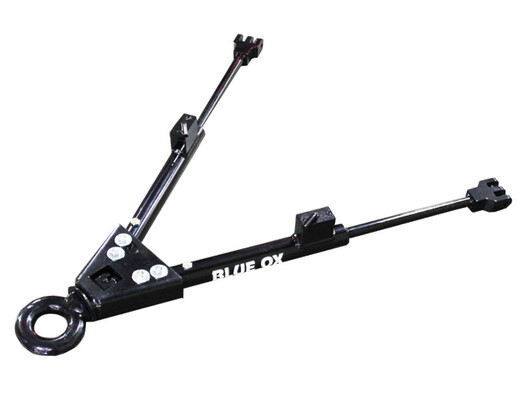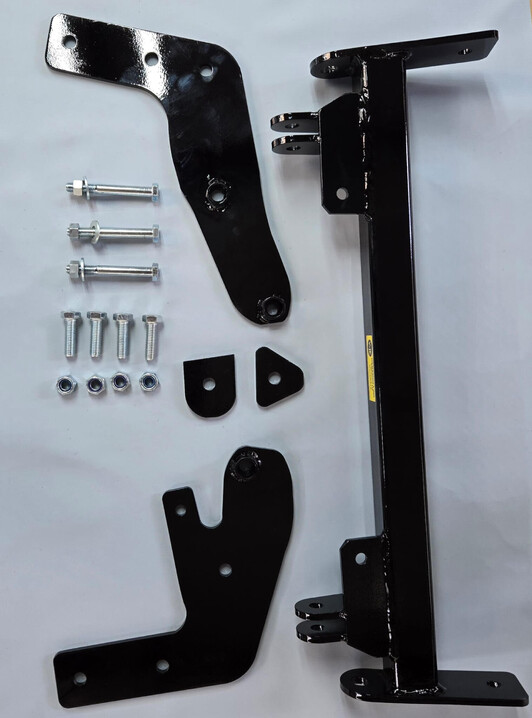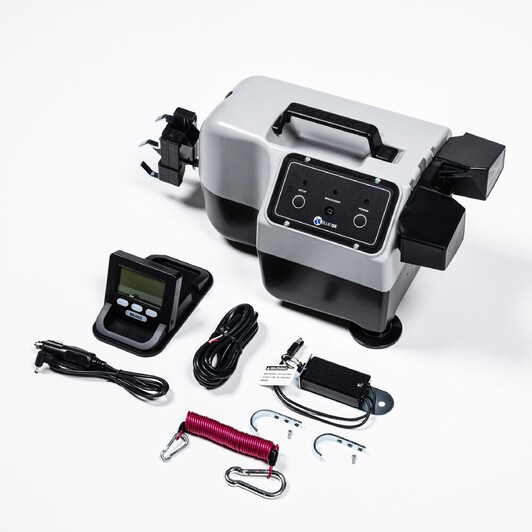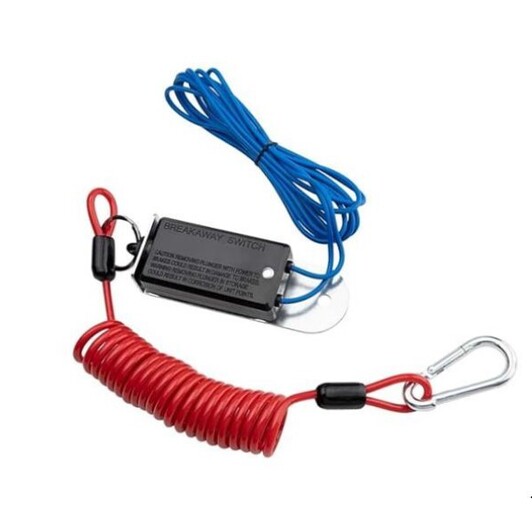Step 2
Steel Towing Frame with Pintel Eye
The steel Trion pintel eye towing frame from Blue-Ox is most commonly used on commercial vehicles. Its uptake is driven by the easy of connecting the towing and towed vehicle. The telescopic arms make it more adaptable than the fixed A-frames, whihc of course should not be left on the front of the towed vehicle as traditionally done by contractors. The regulation states no addedd accessory should be less than 20mm from the frontal most point of the vehicle.
BX7520P - Trion 20K Towing frame (Pintel eye)
Specifications:
Standard triple lugs are sold separately: BX88306
A Blue Ox exclusive – swivel lunette and clevis prevent rollover
Automatic locking pins
Self-aligning
One person hook-up
Deployment does not interfere with other accessories
Wide hook-up zone
No assembly tools required
Folding arms for compact storage
Safety cables included
Premium powder coated finish
Step 3
The Baseplate - what is this?
The baseplate is a vehicle specific steel fitting installed on the towed vehicle to provide physical connection points for the Blue Ox tow frame. Not all vehicles can be towed, if it is a commonly towed vehicle like the Suzuki Jimny, baseplates are typically available ex-stock, otherwise the baseplate may need to be custom made.
Stock baseplates are ~$1285, prices may vary subject to the vehicle.
Installation may range between $200-400.
Step 4
Braking System - Yes or No?
The answer to this question is very simple. The rating on your tow bar dictates whether the towed vehicle must be braked.
Our research suggests the manufacturer of the towing vehicle will stipulate the un-braked rating. If a tow bar manufacturer provides a tested rating for their tow bar, that will supersede the vehicle manufacturer's rating. In the absence of a rated capacity, consult the vehicle's manufacturer. At the risk of making an assumption, the majority of tow bars should be regarded as having a 750kg un-braked rating.
We consulted some New Zealand motorhome insurers and asked "Would a claim resulting from the sudden impact of the towing and towed vehicles be affected by the towed vehicle not being braked when its weight is greater than the un-braked rating of the tow bar?".
Because this was a hypothetical question, the insurers expressed their commitment to support the claims. However, it was contingent on the vehicles meeting all relevant regulations and there being a lack of negligence.
This raised one last question, "Is knowingly not installing a braking unit to the towed vehicle, when it is greater than the rated weight of the tow bar, negligent?"
Step 5
What is a Break-Away system?
Towed vehicles under 2000klgs must have a Break-Away system or a physical connection with the towing vehicle, such as a safety chain(s) of sufficient strength to hold the vehicle in all circumstances. A Break-Away system has a light wire cable connected to the towing vehicle. This cable attaches to a plug which is inserted into the break-away unit bolted to the front of the towed vehicle. In the event of the towed vehicle separating from the towing vehicle, the cable will tension and pull the plug out of the break-away unit. The break-away unit will activate a physical response applying the brakes to stop the towed vehicle. The break-away system is powered by a permanent 12 volt power supply.
Step 6
Electrical system requirements
The towing and towed vehicle must have an electrical connection to ensure all lighting functions such as taillights, brake and indicator lights and number plate illumination are visible on the rear of the towed vehicle. This requires a 7-pin trailer plug or the likes to be secured to the rear of the towing vehicle. The same plug system should be mounted in the front of the towed vehicle with a removable cable spanning across the towing frame connecting both vehicles. In most instances this is a 1-2 hour task. It is worth mentioning some late model vehicles may need an electronic module installed to facilitate management of the towing vehicle's electrical system when an external power demand is imposed.
If a Patriot braking system is used in the towed vehicle, a permanent power supply to the floor mounted brakng unit must be provided. Typically this will be from the cigarette lighter, provided it is active when the towed vehicle is in towed mode. See the section on Vehicle Systems.
Step 7
Installation
Our installation process starts on the presumption a towbar system is pre-existing. Starting at the rear of the towing vehicle, a power supply must be attached to transfer power to the towed vehicle's lighting circuit. Typically this includes a 7-pin plug on the towing vehicle and on the front of the towed vehicle. A detachable cable links the two vehicles. If a breaking unit is included in the setup, this can be installed at the same time as the electrical plugs. This will include installation of the Break-Away switch and ensuring there is a live power source to power the Patriot braking system when in towing mode. Matamata Saddlery has a close working relationship with a local auto-electrical company.
The physical connection between the vehicle is dictated by the nature of the towbar system (hitch, tow ball or pintel). The fitting of a stock base plate typically takes about 2-3 hours. Several concepts of base plates exist, you are invited to discuss these and or talk about custom building a based plate if the towed vehicle is not a Suzuki Jimny. Matamata Saddlery has a close working relationship with a local engineer who produces baseplates and undertakes the installations. We have the option to purchase some of the other baseplates concepts from other New Zealand and Australian engineers as required.
Don't hesitate to call Peter Gates if you have any questions.
Call Peter on 027 2918 106 or email peter@matamatasaddlery.co.nz



